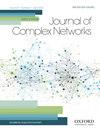电网动力学模型中级联故障的重构
IF 1.5
4区 数学
Q2 MATHEMATICS, INTERDISCIPLINARY APPLICATIONS
引用次数: 1
摘要
在本文中,我们提出了一种重建电网有源链路的方法,该方法由二阶Kuramoto模型描述,并受到动态引发的级联故障的影响。从网络结构已知的假设(对于电网来说是现实的)开始,我们的方法从系统节点的相关动态量的演变,即节点相位和角速度,重建活动链路。我们发现,为了重建断层的时间序列,使用少量样本的时间序列至关重要,因为观测窗口应该小于后续事件之间的时间距离。这一要求与在存在噪声的情况下使用更大的数据集的需要形成对比,使得必须选择在算法中馈送的样本数量作为活动链路重建的预测误差和时间分辨率之间的折衷。本文章由计算机程序翻译,如有差异,请以英文原文为准。
Reconstruction of cascading failures in dynamical models of power grids
In this article, we propose a method to reconstruct the active links of a power network described by a second-order Kuramoto model and subject to dynamically induced cascading failures. Starting from the assumption (realistic for power grids) that the structure of the network is known, our method reconstructs the active links from the evolution of the relevant dynamical quantities of the nodes of the system, that is, the node phases and angular velocities. We find that, to reconstruct the temporal sequence of the faults, it is crucial to use time series with a small number of samples, as the observation window should be smaller than the temporal distance between subsequent events. This requirement is in contrast with the need of using larger sets of data in the presence of noise, such that the number of samples to feed in the algorithm has to be selected as a trade-off between the prediction error and temporal resolution of the active link reconstruction.
求助全文
通过发布文献求助,成功后即可免费获取论文全文。
去求助
来源期刊

Journal of complex networks
MATHEMATICS, INTERDISCIPLINARY APPLICATIONS-
CiteScore
4.20
自引率
9.50%
发文量
40
期刊介绍:
Journal of Complex Networks publishes original articles and reviews with a significant contribution to the analysis and understanding of complex networks and its applications in diverse fields. Complex networks are loosely defined as networks with nontrivial topology and dynamics, which appear as the skeletons of complex systems in the real-world. The journal covers everything from the basic mathematical, physical and computational principles needed for studying complex networks to their applications leading to predictive models in molecular, biological, ecological, informational, engineering, social, technological and other systems. It includes, but is not limited to, the following topics: - Mathematical and numerical analysis of networks - Network theory and computer sciences - Structural analysis of networks - Dynamics on networks - Physical models on networks - Networks and epidemiology - Social, socio-economic and political networks - Ecological networks - Technological and infrastructural networks - Brain and tissue networks - Biological and molecular networks - Spatial networks - Techno-social networks i.e. online social networks, social networking sites, social media - Other applications of networks - Evolving networks - Multilayer networks - Game theory on networks - Biomedicine related networks - Animal social networks - Climate networks - Cognitive, language and informational network
 求助内容:
求助内容: 应助结果提醒方式:
应助结果提醒方式:


